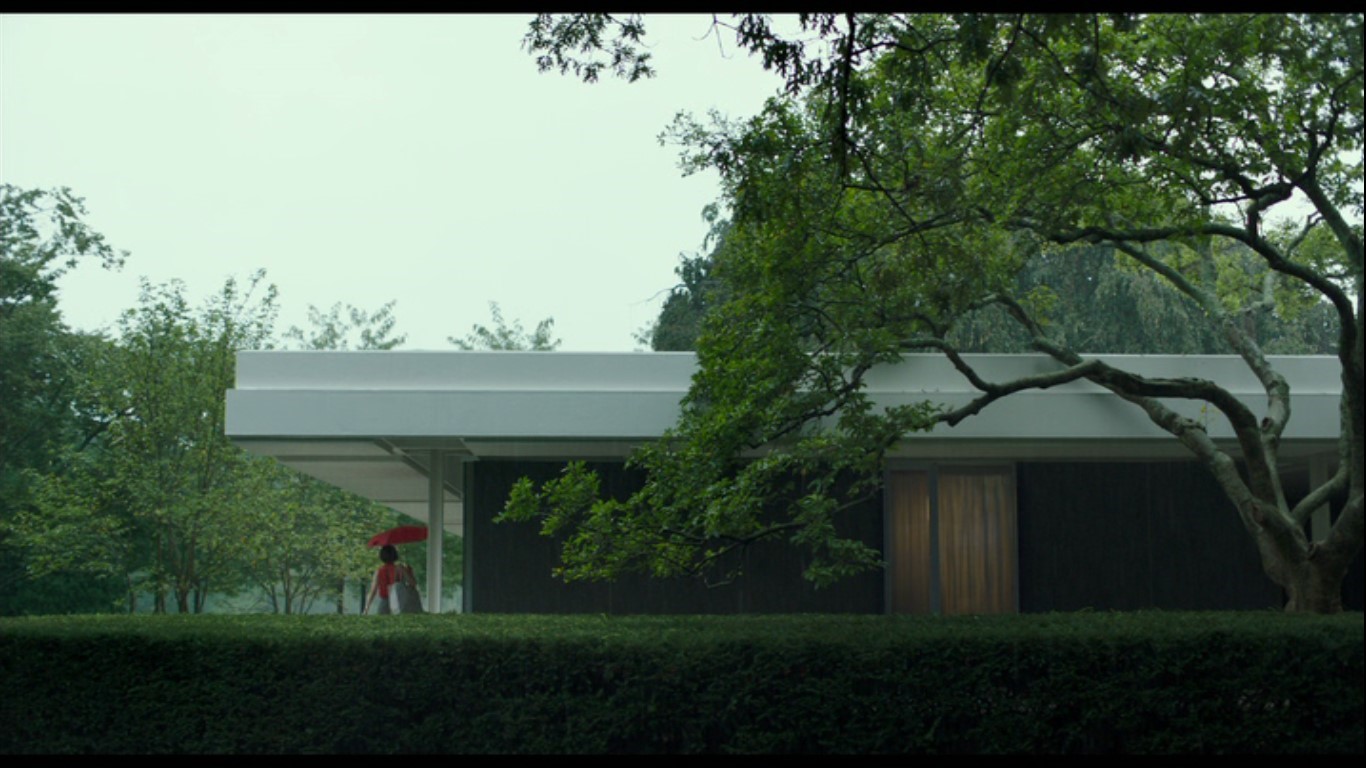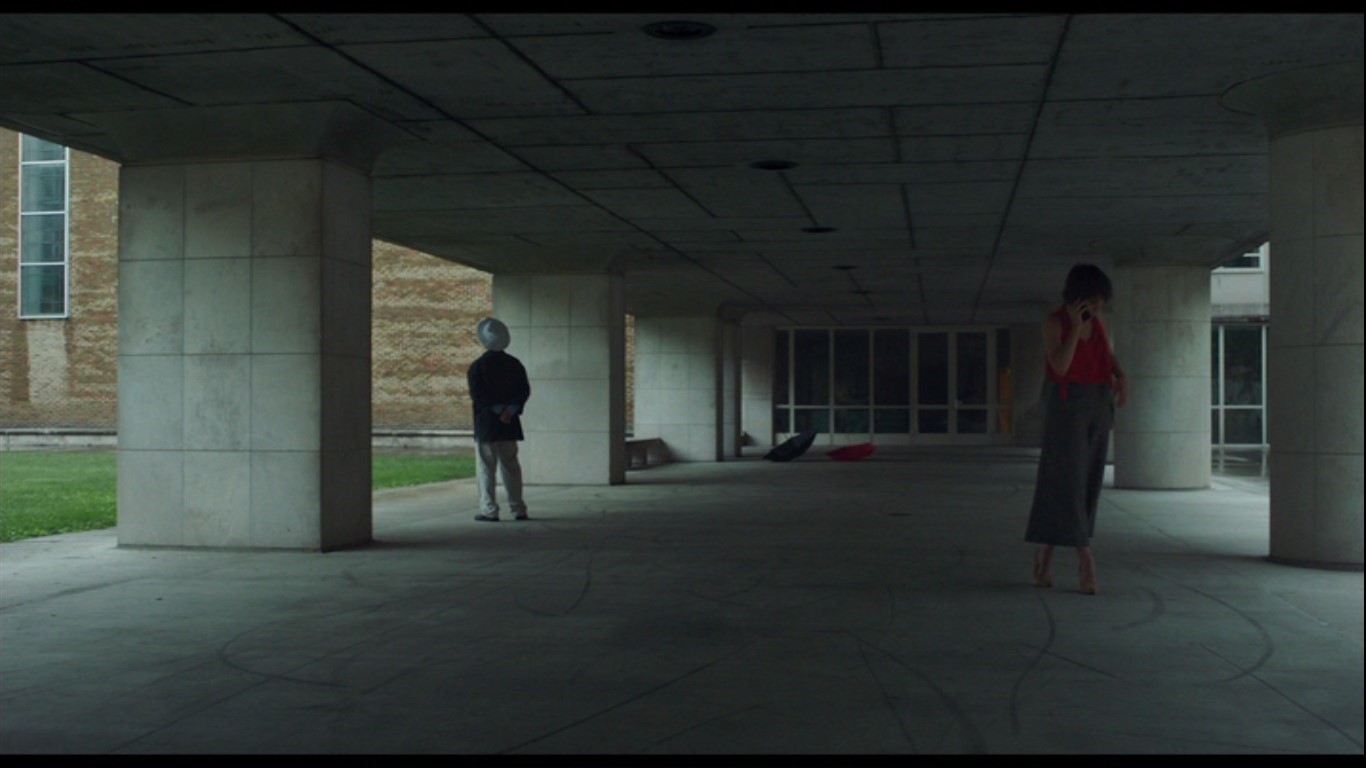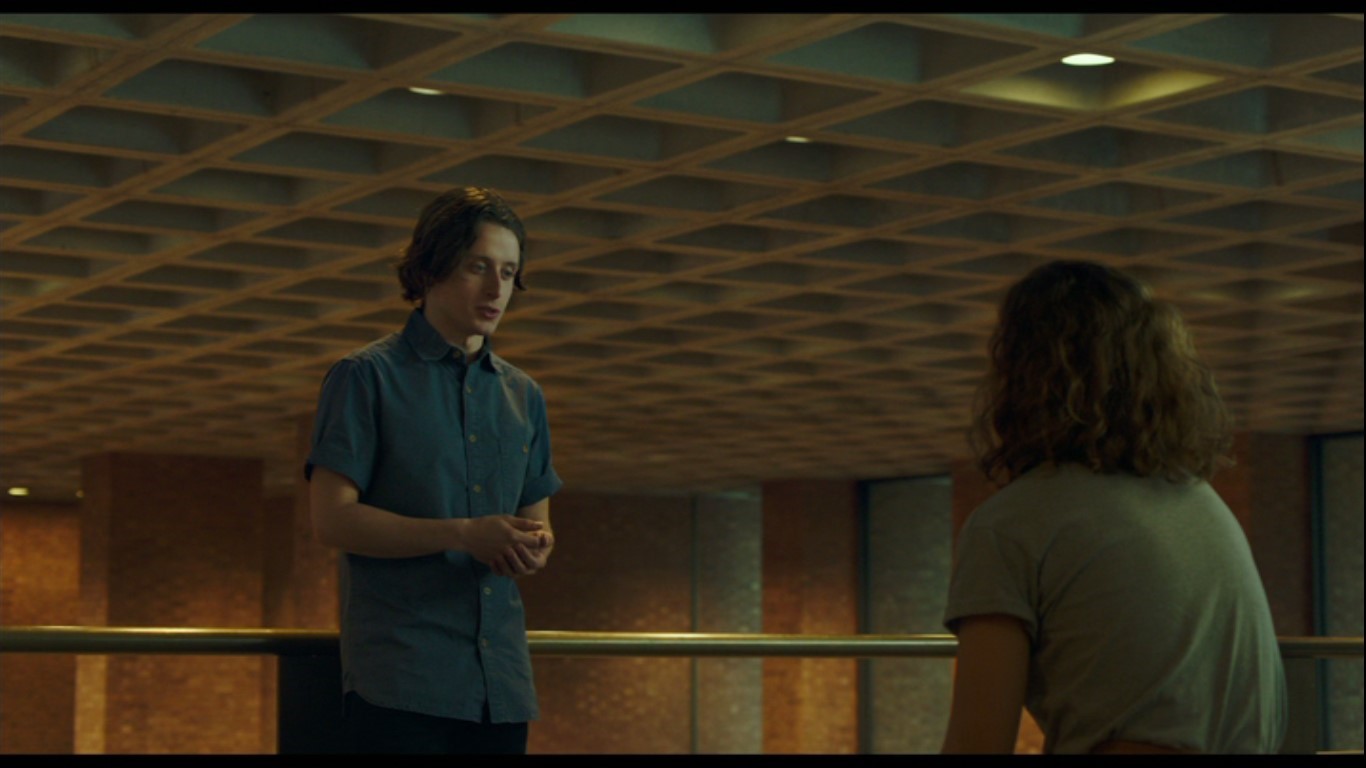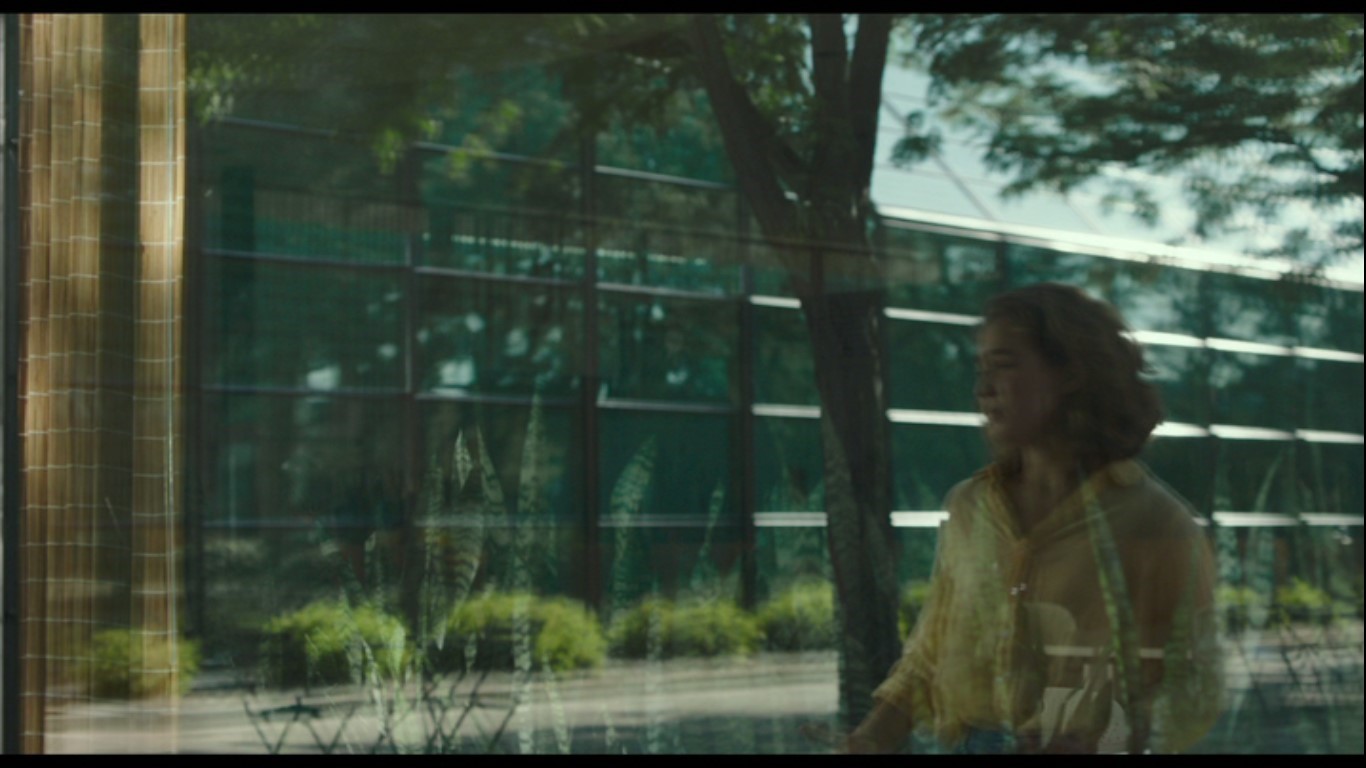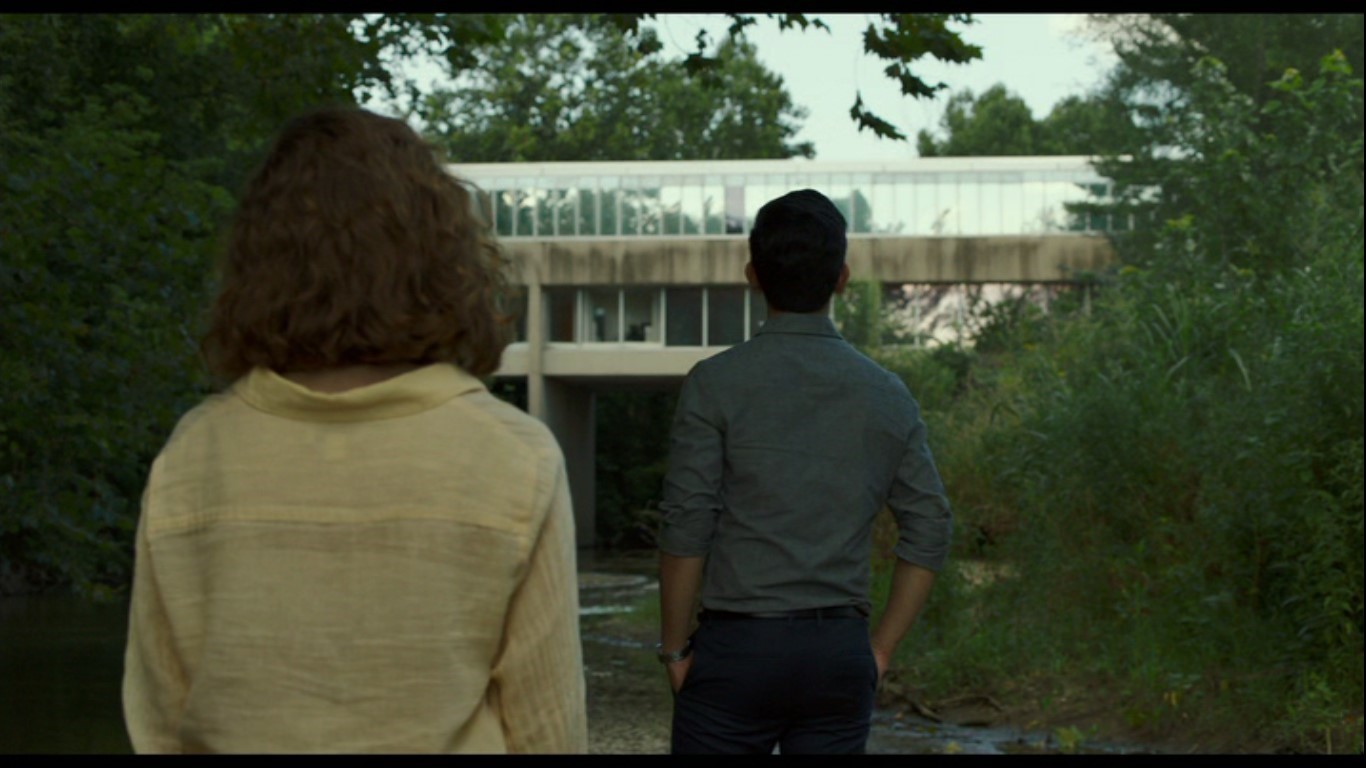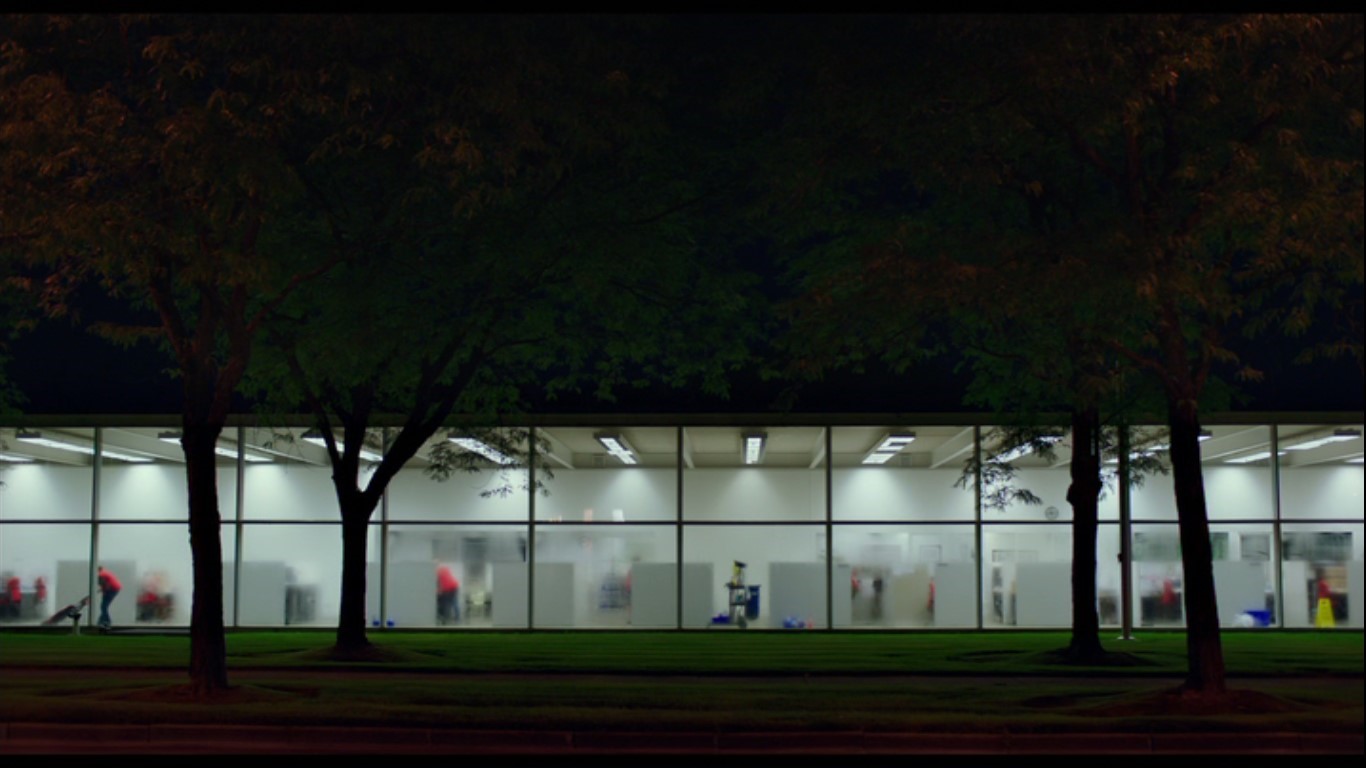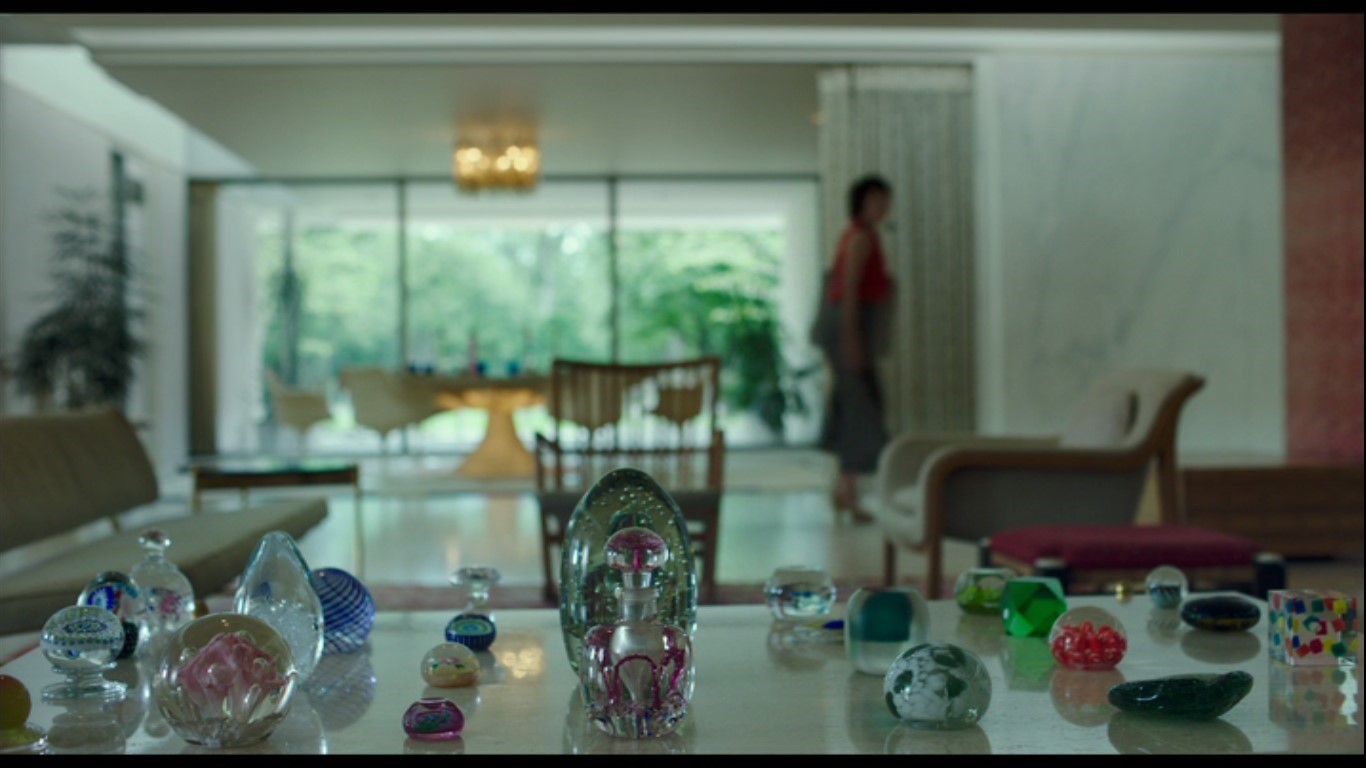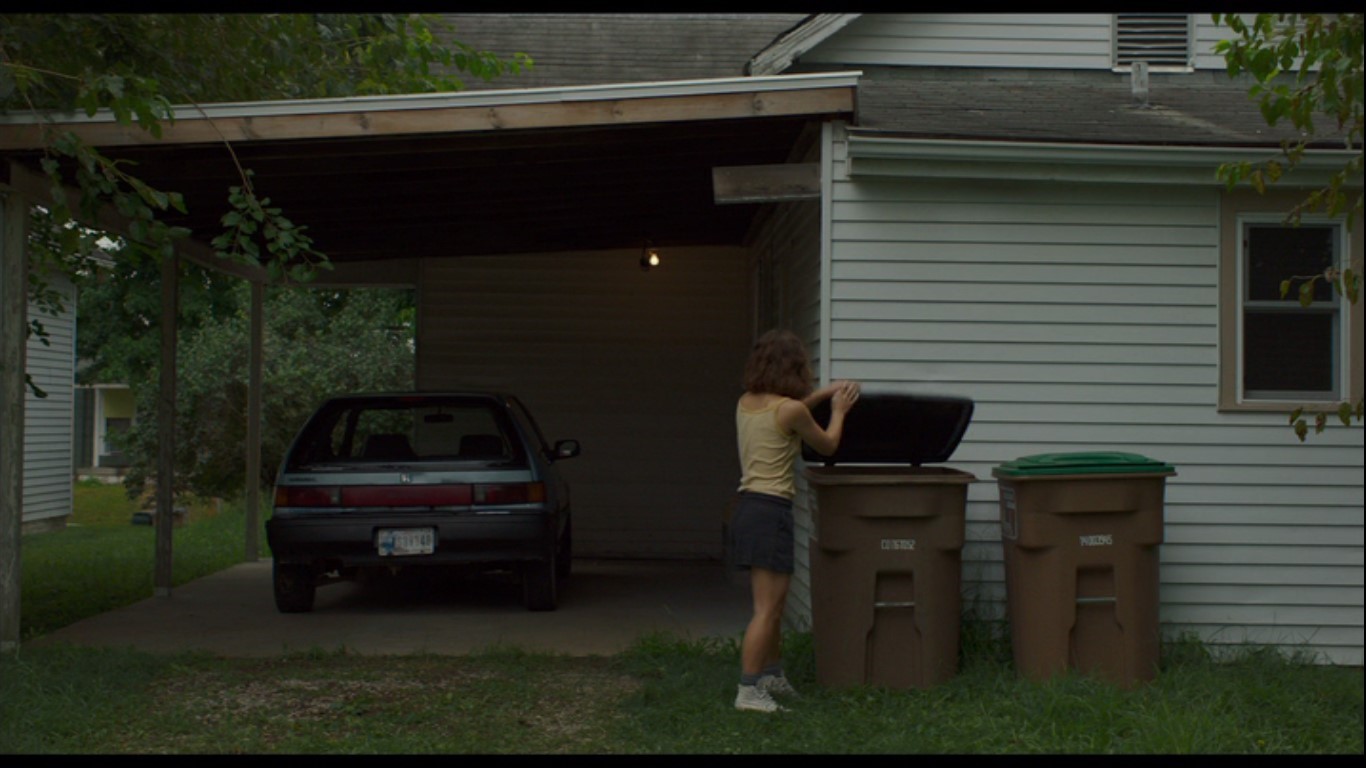Kogonada’s Urban Neorealism
Skip other details (including permanent urls, DOI, citation information)
: This work is licensed under a Creative Commons Attribution-NonCommercial-NoDerivatives 4.0 International License. Please contact [email protected] to use this work in a way not covered by the license.
For more information, read Michigan Publishing's access and usage policy.
Abstract
Kogonada’s first full-length feature film, Columbus (2017) is about a little-known Midwestern city and bastion of modern architecture. In method and content, Columbus is both ethnographic and playful, documentary and fiction. This article argues that Kogonada embodies a neorealist filmmaking method and in doing so defies traditional boundaries on multiple levels, prioritizing marginality through a preoccupation with visual lingering. Through its neorealist, ethnographic gaze, the film critically attends to entrenched hierarchies and divisions regarding gender, race, built artifacts, and socioeconomics. As a neorealist project, Columbus is an emotive meditation on urban space and rich visual theory of architecture, design, and metropolitics.
Introduction
Deep in flyover country, somewhere south of Indianapolis, north of Louisville, and west of Cincinnati, lies one of the nation’s best-kept architectural secrets. Columbus, Indiana, home to Fortune 500 company Cummins Inc., is better known in architecture and design circles as “Athens of the Prairie.” This industrial city doubles as an ongoing experiment and architectural laboratory for mid-century modern and contemporary design. Since the 1940s, the city has drawn movers and shakers from the top echelons of the design world. To name only a handful of the many architects, designers, and artists that have worked in the city, Eliel and Eero Saarinen, Charles Eames, Alexander Girard, Robert Venturi, Richard Meier, Deborah Berke, Jean Tinguely, and Dale Chihuly have all contributed projects. Until recently, unless one was an avid Dwell or Architectural Record reader, the likelihood for the general public of knowing about Columbus’s architectural significance remained low. But in 2017, first-time director Kogonada’s feature film, Columbus, produced by Oscilloscope Pictures, brought the Midwestern city to the attention of art house and independent cinema audiences across the world.
From an urban studies perspective, Kogonada’s Columbus offers both a visual meditation on the contested ideological-political fabrics that constitute cities as well as an applied filmic critique. As urban formations, cities are besought with internecine boundary issues, both internal and external, as well as with ongoing contestations over identity, values, and ethos. This article discusses the means by which Columbus understands these tensions and illustrates them in compelling and nuanced ways. I argue, first and foremost, that Kogonada finds inspiration in a neorealist filmmaking style that emerged primarily in postwar, 1940s Italy in opposition to fascist political-ideological undercurrents and romantic cinematic sensibilities.[1] Kogonada’s neorealism, like that of his Italian predecessors, challenges the boundaries of mainstream filmmaking and defies the predictability of Hollywood cinema. Critics have described Columbus as a “cinematic love story” about its urban namesake,[2] but my own ethnographic research suggests that this description is somewhat misleading. Kogonada does not satirize or spoof modern architectural forms—i.e., he does not see them exclusively as sites of alienation and anomie, as is tradition in both mainstream and independent cinema—but neither does he romanticize or idealize these built forms. This article documents and describes the methods by which Kogonada defies entrenched boundaries through an adapted form of neorealist filmmaking. As discussed in the following pages, neorealism is the philosophy, medium, and paradigm through which Columbus blurs documentary and fiction, engages architectural theory via narrative, dialogue, and visuality, casts buildings as veritable actors, leverages an implicit feminist critique, attends to everyday life, and rejects the monumental and the heroic, in both architectural and cinematic senses.
Situating Columbus
Columbus tells the story of Jin (John Cho), the son of an architecture scholar who, following the professor’s sudden hospitalization, finds himself marooned in the Midwest and unsure about his identity and future. But this town is no ordinary, run-of-the-mill rural enclave in the heartland. In real life, and as Kogonada explores cinematically, Columbus has earned its status as a “Mecca” or “Utopia” of modern architecture and contemporary design. Given the concentration of the city’s modernist efforts and attention to urban planning and public space, it’s fitting to describe Columbus as the North American Brasilia.[3]
Through a series of events, Jin meets Casey (Haley Lu Richardson) and much of the film’s 104 minutes features the duo in deep conversation nearby or inside Columbus’s key architectural sites. Eero Saarinen’s Miller House and Gardens, North Christian Church, and Irwin Union Bank; Eliel Saarinen’s First Christian Church; Edward Bassett’s City Hall; Michael Van Valkenburgh’s Mill Race Park; James Polshek’s Quinco Regional Mental Health Center; and Myron Goldsmith’s Republic Building, among many others, make appearances. A Columbus native, Casey works part-time as a tour guide. She knows the sites well and in multiple scenes runs lines to herself, verbally performing an impressively long inventory of architectural facts. Casey is also a part-time librarian, so a fair amount of screen time features I.M. Pei’s photogenic Cleo Rogers Memorial Library, the bordering city plaza, and the Avenue of the Architects.
As an anthropologist studying architecture and built social environments, Kogonada’s and my own interests overlap. I was pleasantly surprised, for one, to see that Jin’s father, the architecture scholar, was researching the two famous Saarinen churches in the city: First and North Christian. Jin discusses, momentarily, his father’s latest research. “He was writing something on the Saarinen churches,” Jin relays to Casey. “Something about the paradox of modernism and religion.” I’m currently working on a project that also focuses on the two churches. Eliel Saarinen’s First Christian, completed in 1942, is one of the earliest examples of midcentury modernism applied to religious architecture in the United States. The film, in some sense, is about people like me who visit the city for research purposes to write about buildings as well as about architects and the people who inhabit built structures. But there were additional similarities between our anthropological and cinematic projects.
We both, for instance, discovered the city by accident. Kogonada grew up in the Midwest and often passed by Columbus via interstate but only as an adult learned about its distinctiveness through a New York Times feature.[4] I keenly remember my first impressions of the city. Walking around on foot I was duly impressed and bewildered by the concentration of rectilinear, modern, avant garde, and glass-façade buildings I had spied in a matter of mere blocks. Like Kogonada, who eventually visited the city in person, I knew I had stumbled upon something exceptional.
Back home after the trip I researched online only to confirm my initial speculations of exceptionality. Not only was Columbus a certified architectural anomaly; it ranked sixth in the nation for modern design according to the American Institute of Architecture. Only the urban metropolises of New York City, Boston, Washington D.C., Chicago, and San Francisco outranked this modest sized town. Fast forward several years, I now spend time in Columbus on a regular basis, conducting ethnographic research in the architourist circuits that fuel the city’s economy, observing interactions between tour guides and tourists, interviewing architects, city officials, designers, artists, educators, and residents. In short, my ongoing project attempts to gain a first-hand understanding of the city as a progressive architectural, social, economic, industrial, religious, and political experiment. Like my own academic interests, Kogonada’s Columbus delves deeply into these and other inquiries into the ontology of modernism and the influential (if implicit) influence of the built environment on everyday life.
Neorealism and Critique
Consider, first, Kogonada’s neorealist agenda. Kogonada made a name for himself after dropping out of a doctoral program in film studies to focus on making short, experimental films about directors and cinematography. The center contention of this article is that neorealism is a filmic genre, philosophy, and style that Kogonada applies to his own work. But what exactly is neorealism as realized by this contemporary director? According to a short video essay created by the director for Sight & Sound, neorealism breaks with traditional Hollywood cinematography in its focus on moments deemed narratively “excessive.”[5] In neorealist filmography the camera’s gaze dwells on characters, scenes, and settings that are not immediately necessary or central to the film’s primary narrative. Neorealist filmography decenters the assumption that a single narrative is required.
To further unpack this philosophy, one might describe neorealism as a form of methodological and stylistic resistance against the standard filmmaking techniques that weigh each scene’s productivity and efficiency in carrying the linear narrative forward. Neorealism focuses on visual marginalia and gets intentionally lost in the details happening behind the protagonists or at the margins of the frame. Neorealism is slow and processual in method. It’s about what Kogonada identifies as visual lingering. The method is also intentionally anti-hierarchical. Neorealism, in Kogonada’s words, “lingers on extras that we’ll never get to know” and intentionally “decenters the primary characters.” For mainstream filmmakers, “lingering on those that add nothing to the story is considered excessive, or even worse, a distraction, derailing the plot or drawing attention away from the stars. It is an unnecessary diversion.” In Kogonada’s hands, neorealism as a filmmaking style and philosophy indulges and even accentuates visual diversions, preferring marginal excesses to any coherent center.
In one particularly memorable Columbus scene, Casey and her librarian coworker, Gabriel (Rory Culkin) are lost in discussion about the details of some extensive stretch of marginalia he found in one of the library’s return materials. The two agree that this instance of marginal commentary is likely the product of some graduate student. The conversation is a deeply arcane and philosophical consideration of attention spans in contemporary society. At one point, Gabriel interjects, channeling the voice of the marginalia writer: “What about everyday life? Are we losing interest in everyday life?” This discourse itself, about something as marginal as marginalia, is indeed a neorealist gesture. Viewers observe Casey and Gabriel conversing. But the neorealist gaze, bored with a straightforward linear account and troubled by the hierarchy between such binaries as stars vs. extras, breaks its focus to inspect—even meditate on—the surroundings of the second floor of Pei’s immaculate midcentury modern public library.
This scene, in fact, takes place in what one local tour guide I met during fieldwork calls “the Oasis,” an ambient, moody space located in a tucked-away place, just under a skylight that opens onto a square grove of dense indoor plants. A Columbus native, the real-life guide explained in detail how in high school he liked to escape up to the Oasis after classes, finding the somewhat hidden public space on the second floor both liberating and peaceful. Kogonada’s camera, for significant parts of the scene, trains not at Casey and Gabriel, the identifiable stars, but at an anonymous library staff person who is visibly into the music channeling through his headphones as he waters the plants, moving the hose nozzle back and forth, back and forth, plants shuddering, slightly, under the weight of their hydration.
The Oasis scene is neorealism embodied. For Kogonada, what Hollywood “sees as waste and excess becomes the essence of a different kind of cinema and sensibility in which shots linger and veer off to include others, in which in-between moments seem to be essential, in which time and place seem more critical than plot or story.”[6] The textures of Pei’s honeycombed ceiling perforations and the mesmerizing shower of water flowing onto the plants takes center stage. Neorealism is defiance and critique. These mise-en-scène minutiae are the story.
The film’s neorealism, I’d further argue, qualifies Columbus as an ethnographic project. The anthropological consensus is that ethnography is the first-hand, immersive, long-term study of particular social and cultural groups in their natural settings. Armed with their primary method of thick-description ethnography, anthropologists, like neorealists, focus on social and cultural minutiae.[7] Social sciences training notwithstanding, Kogonada checks all the ethnographic boxes. He spent significant time researching in the city and did work in the archives. He got to know Columbus locals, learned the culture, and was enculturated into the ebbs and flows of the town. Kogonada took his neorealist convictions seriously, hiring residents to play library and restaurant staff, local workers, and other support roles.
To see the city as an anthropologist sees it, watch Columbus. Viewers hear, near verbatim, the very language that the tour guides—the city’s official urban mythologists, story keepers, and applied historians—who lead design pilgrims and architecture buffs around the city, offering commentary on buildings designed by Saarinens, Peis, Venturis, Meiers, or Fletchers. Viewers will catch snippets of the selfsame language I encountered while studying the architourist networks around the city last summer.
By my reading, Columbus belongs in the genre of visual anthropology, alongside Margaret Mead and Gregory Bateson’s Bathing Babies in Three Cultures (1941), John Marshall’s The Hunters (1958), Jean Rouche’s Chronique d’un été (1961), Robert Gardner’s Dead Birds (1964), and, most recently, Lucien Castaing-Taylor and Véréna Paravel’s immersive sensory ethnography, Leviathan (2012).[8] In their Cross-Cultural Filmmaking: A Handbook for Making Documentary and Ethnographic Films and Videos, Ilisa Barbash and Castaing-Taylor deconstruct the false ideal of “objectivity” in documentary film and celebrate the similarities of ethnographic and fictional movies. Barbash and Castaing-Taylor encourage fictional-realist blurring in filmed representations, re-describing ethnographic subjects as characters or actors performing in the theaters of their own life-worlds. According to these filmmakers, “documentary conventions of character development over the course of a film are uncannily close to fictional ones.”[9] Kogonada’s neorealism corroborates such a genre-defying association. Columbus blends the real with the imagined; the film is both documentary and fiction.
Actor-Buildings and the Social Lives of Glass
Unlike French director Jacques Tati’s films, especially Mon Oncle (1958) and Playtime (1967)—films which creatively cast buildings as actors and personalities but found humor and awkwardness in the foibles of modernism—Columbus takes modernist architecture seriously.[10] At the same time, Kogonada’s sanguinity as applied to architecture breaks paths with the neorealist tradition, qualifying his interpretation of neorealism as unique. Italian director Michelangelo Antonioni worked early in his career with Roberto Rossellini, who, along with Vittorio De Sica, helped to establish Italian Neorealism. Whereas Antonioni’s later films—e.g., L’Eclisse (1962) and Red Desert (1964)—situate modern domestic, urban, and industrial settings as sites of psychosocial malaise and alienation, Kogonada acknowledges the connection of modernity to anomie even as he entertains a more generous reading of modern forms.[11] As I’ll describe below, Kogonada’s quasi-optimistic portrayal alters the imageability of the city, to draw on Kevin Lynch’s phrasing, giving modern architecture the benefit of the doubt.[12]
But can a quasi-fictional feature film delve into heady architectural theory using the two-dimensional medium of the movies? In Columbus, the numerous architectural subjects that feature in the movie are not simply iconic fictionalized settings or mere theatrical backdrops. As in Thom Anderson’s Los Angeles Plays Itself (2010), this city’s buildings “play themselves” and command the screen, as one critic puts it, “more like actors than scenery.”[13] That these buildings are “actors” possessing a degree of agency over and influence on their human inhabitants comes through in Kogonada’s film. Columbus’s buildings take on the attributes of the human. These non-human persons and personalities, in fact, have the power as built structures to influence not only people’s moods but their everyday rituals and patterns of daily life. Columbus is an ongoing experiment about whether architecture and design can influence happiness, productivity, and heighted perceptions of the quality of life.
In some vignettes, Columbus as an applied visual-architectural theory perhaps even exceeds the abilities of theory in written, academic form. Take glass as symbolic material for built modernism. As Jean Baudrillard describes the substance, the metaphysics of glass “the material used and the ideal to be achieved, both end and means.”[14] In the modernist purview, glass has symbolically been associated with purity, hygiene, transparency, fluidity, and openness.[15]
Glass plays a foundational role in Columbus. Students of Mies van der Rohe have (literally) shaped the city. Mies’s protégé, Myron Goldsmith, of Skidmore, Owings & Merrill, contributed The Republic Building, a glass-encased tribute to the master of glass. Eero Saarinen was a domestic Miesian. Even the most novice of architecture aficionados have no trouble identifying the visual cues indebted to Mies in Saarinen’s rectilinear, glass-façade structures including the Miller House and the Irwin Union Bank.[16] Mies canonized glass for the International Style. Indeed, classic modernists coming out of the Bauhaus in Germany saw glass as a symbolic substance that prioritized transparency and aided in dismantling Old World social, cultural, traditional, and religious powers. As these dogmatic modernists averred, spatial transparency had the ability to deconstruct entrenched hierarchies (e.g., that pesky binary of public vs. private).
Kogonada enters this discussion about the symbolism of glass and the affective power of built structures. Consider the interchange between Casey and Jin that occurs next to Eero Saarinen’s Irwin Union Bank, one of the first modernist, glass-walled banks in American history. The building is second on Casey’s list of favorites. After Jin inquires about the edifice, she switches into “tour guide mode” (Jin’s words) and rambles off a series of architectural facts about the building’s uniqueness. Abruptly, Jin stops her mid-sentence.
Jin: “Do you like this building intellectually, because of all the facts?”
Casey: “No. I’m also moved by it.”
Jin: “Yes, yes! Tell me about that. What moves you?
Casey: “I thought you hated architecture.”
Jin: “I do. But I’m interested in what moves you, particularly about a building.”
Directly following Jin’s line about buildings emotively moving human interactants, Kogonada shifts the camera into an unexpected third position: behind the glass and into the interior of Saarinen’s bank, focusing on Casey’s body language and expressions as she breaks out of tour guide mode, out of her role as “arbiter or tidbit facts,” as Jin puts it. Casey gives what one assumes is a less factual and more personal rendering of the building to Jin. We observe her lips moving and her hands gesturing at shapes and dimensions. Viewers note the affection and bliss radiating from her expressions. Casey beholds this building as if it were a loved one (or lover). But unless the viewer reads lips, her actual, semantic language escapes us. We don’t hear why she loves the building, but we do observe the joy and pleasure that it brings her. The background score swells in this moment, perhaps to compensate for the sudden sensory deprivation and lack of Casey’s audible voice due to the camera’s containment behind the glass.
Shortly after the bank scene Casey and Jin visit other sites in the city. They pause by Haw Creek, which flows under James Polshek’s Mental Health Building.[17] Kogonada, again, dwells on the murmuring river and swaying organic life on the periphery of the central narrative. In this scene, Casey and Jin invert roles. Jin reports to Casey what he knows about Polshek’s architectural theory from a book he found in his father’s hotel room.
“He had this idea, Polshek did, of architecture being this sort of healing art,” Jin comments. Polshek believed that architecture “had the power to restore. And that architects should be responsible.” “All the details of this building are mindful of that responsibility,” he continues, “especially since it was a structure for mental health. This building was meant to be both a literal and metaphoric bridge.”[18]
Later in the day Kogonada returns to the theme of glass when Casey and Jin observe The Republic Building from across the road. “More glass,” says Jin, commenting on the building’s sleek lines and glowing radiance after dark. “More glass,” Casey confirms. Jin continues his interpretive commentary: “Transparency. Light.” Replies Casey: “This is number five on my list.”
Casey pulls out her phone and makes a call. The camera zooms into the side of the building, where after-hours cleaners, wearing red vests, come into focus through the transparent glass. One of those cleaners, we find out when Casey calls and leaves a voice message, is Vanessa, a close friend of Casey’s mother. We watch as Vanessa at first acknowledges the incoming call but ignores it, going back to cleaning. She answers it the second time, but the dialogue is one-sided. The glass, like before, reveals some things but conceals others. As Baudrillard theorizes, glass is in some ways misleading.[19] The material’s abstractness and clarity of sight suggests transparency and openness of communication but it not always entirely the case.[20]
The situation is not entirely clear, but we pick up on the fact that Vanessa is lying on behalf of Casey’s mother. The tension between the troubled mother and the concerned, dutiful daughter, is at this moment on full display, even as the strained relationship is mediated through a complex network of glass, mobile communication technology, and friendship nodes. Jin seems oblivious to the family drama that has just played out in front of him through the wall of The Republic. The cleaners are, to him, anonymous.
Kogonada’s implicit meta-commentary emerges in this scene in full force, signaling back to the mediated discussion that occurred at Saarinen’s bank. Glass reveals and conceals. Glass displays and hides and symbolizes. Glass bespeaks transparency but is also disposed towards exclusion and control.[21] If The Republic Building is an actor and agent in Kogonada’s narrative, in this scene the building plays the role the giddy child who, brimming over with excitement, just can’t bear to keep the promise they swore only moments prior that they would. One glass building is an icon, a person of significance, or a lover, a place of deep meaning and joy for Casey. Another is an immodest spiller of secrets. Still a third building, as we will see shortly, is for Casey a loyal friend and confidant, a source of hope and optimism for a better future.
Kogonada’s Myth-Dismantling: Gender and Race
Kogonada’s neorealist tendencies allow him to defy Hollywood norms, blend the ethnographic with the fictional, refocus on marginalia, and speak through cinematography and narrative to architectural and design theory. Directly correlating with the neorealist attention to the margins, there is still another, implicit star of the movie, a real-life figure who, quite cleverly, does not show up directly in the film even once. Columbus boasts a list of some 60 high profile architects who have contributed projects in the city. Very few of these principals are women. Unfortunate as it is, this situation reflects the broader discipline of architecture’s historic gender imbalance.
Architect Deborah Berke, recently appointed the first female dean of the Yale School of Architecture, is also one of few women who can claim to have built in the city.[22] Berke’s First Financial Bank, originally an Irwin Union Bank branch, features prominently in the film and has earned the rank of number four in Casey’s personal list of favorite local buildings. For long segments of screen time, Casey and Jin observe the building, discussing its understated aesthetic draw, the way the structure blurs the mundane and the special, the commercial and the contemporary. During a particularly difficult time in Casey’s life, she started coming to see the bank at night. “I found it weirdly comforting. In the middle of all the mess, in this fucking strip mall, there was this . . . this . . .”. She struggles to put her thoughts into words and gestures in the air, cigarette in hand, tracing the four sides of the rectangular glowing box. “I don’t know. I sort of weirdly became obsessed with this building after that,” she continues. The duo stands near Casey’s car after dark, the floating, rectangular box of the bank hovering above them. Casey explains her passion for architecture to Jin, noting at one point how she had attended Berke’s lectures during special events in Columbus, had gotten to meet the architect, and had even communicated with her about a possible internship in New Haven.
At the end of the film, the real-life Berke is the invisible hero, of sorts, who’s generous offer aids Casey in her life-altering decision. That out of all the buildings in the city Kogonada chooses Berke’s bank to be Casey’s personal obsession is a decidedly symbolic gesture. One way to summarize the situation is that Kogonada’s Columbus, as a neorealist, ethnographic project, has a deep feminist undertone.[23]
In its subtext, the film thinks about equity in terms of gender as well as race. This situation makes sense given Kogonada’s intentional focus on margins and marginalia. Gender inequality is an issue in architecture circles, but Hollywood has its own implicit and explicit issues about race and racism. Kogonada has went on the record about how in the filmmaking process for Columbus he fought strong resistance from potential producers who opposed his decision to star an ethnic minority as one of the film’s leading characters. In one interview, the director noted that
Some financiers said to us: “You want an Asian-American male lead? There’s no interest in that.” Now you have Crazy Rich Asians and Searching [also starring Columbus’s John Cho]. People used to say that about movies featuring African Americans, that the audience would be exclusively African American. They’re just myths that are being challenged.[24]
Born in Korea but raised in the American Midwest, Kogonada is particularly attuned to these sorts of racialized “myths” that require dismantling. Columbus is a neorealist exercise in the deconstruction of problematic cultural mythologies of various sorts.
Everyday Life and the Anti-Monumental
In one final direction, Kogonada’s film eschews entrenched standards. Columbus’s neorealism offers the filmic version of the post-Marxist turn to everyday life in academia, encapsulated in the works of theorists of cities, space, and buildings.[25] Columbus defies rigid boundaries in a way that aligns with urban anthropology’s interest in how architecture influences everyday life. Drawing on Henri Lefebvre’s critical work on the everyday and the ideological complexities of urban formation, I’m concerned with the ongoing contestations that constitute cities. Tour guides, promotional materials, journalists, and architectural commentators all depict Columbus in a certain way. In a public, professional, polished sense, Columbus is a clear exception to the Midwestern mundane. The city’s existence is its own form of symbolic boundary disruption. But in real life there are alternative voices that do not always speak positively of Columbus’s architectural progressivism. A handful of highbrow critics, for instance, have challenged rather than reinforced Columbus’s status as a design mecca.[26]
Additionally, sometimes local inhabitants themselves, both natives and newcomers, interpret the city’s midcentury modern seriousness in playful and heterodox ways. I encounter these alternative readings of Columbus’s architectural projects frequently enough in the field that I have started marking them in my fieldnotes as performances of “Real Columbus” or “Alternative Columbus” (i.e., opposed to versions “Public” or “Official”). Manifestations of Alternative Columbus, as I’m describing them, include locals who interrupt official tours to describe Henry Moore’s Large Arch, stationed in the middle of the city plaza, as “Godzilla’s leg-bone.”[27] Likewise, Harry Weese’s Eastbrook Plaza Branch Bank has earned the unfortunate yet endearing moniker of the “Dead Horse.”
Kogonada, to repeat, has not written a visual love letter to Columbus, at least not in an idealized, blindly optimistic manner. Columbus is as attuned to Alternative Columbus as it is to Public Columbus. Alternative Columbus includes local life outside of the polished downtown sector. Alternative Columbus involves life “on the other side of the tracks,” to use a figurative colloquialism that in the case of historic Columbus applies literally. Casey comes home in the evenings to a troubled, single-parent situation and lives in a low socioeconomic residential area. A recovering drug addict, her mother represents the meth crisis that has paralyzed Heartland America and from which Columbus, utopian airs aside, is by no means immune.[28]
Additionally, there are fascinating contrasts between the domestic settings portrayed in the film. On the one hand, Saarinen’s Miller House, as Casey’s number one and the building with which Kogonada chooses to open his narrative, is a stellar example of midcentury domestic modernism. As iconic as Mies’s Farnsworth House and Philip Johnson’s Glass House, the home’s rigid structural modernism finds relief in the warmth of interior designer Alexander Girard’s bold use of colors, textures, and materials.
On the other hand, this home filled with art, sculptures, and custom Eames furniture contrasts Casey’s humble domestic space in its shingled vernacular exterior and cozy yet tasteful interior. Kogonada is aware of the scalar difference in class and prestige that viewers might identify in these contrasts. But there are subtle hints that Kogonada aims to make the hierarchy less hierarchical.
In the Miller House, during the first few moments of the film, the camera hovers over Xenia Miller’s vast glass paperweight collection, put together, in combination with Girard’s assistance, from the family’s travels all over the world. In Casey’s home, the coffee table scene repeats on a more modest scale, the camera tracing over glass orbs of similar colors, hues, and transparencies. These visual cues move in the direction of inclusivity and consonance.
In his concern with everyday life, Kogonada also concentrates the camera’s gaze on the city’s non-monumental sites. “The city is a veritable mecca of modernist architecture, and Kogonada revels in filling his frames with the monumental grandeur of landmarks like the towering red Robert N. Stewart Bridge and Eliel Saarinen’s glass-fronted First Christian Church,” writes Aline Dolinh for Film School Rejects.[29] Although Columbus does feature gratuitous shots of buildings by Saarinens, Meiers, Peis, Venturis, Pelis, and Berkes, it also lingers on Columbus’s untoward urban excesses and marginalia, on the generic and anonymous aspects of what Deborah Berke herself, an architect, writer, and theorist, describes as the architecture of the everyday.[30] In this direction, the director’s neorealist style is again in dialogue with architectural theory. Kogonada’s camera captures the haze of golden hour in gravel alleyways and the untoward, overgrown yards just outside of the pristine downtown.
Scenes filmed in these Alternative Columbus spaces linger on the weeds growing through aging concrete, crates leaning against walls, peeling paint, and rusting pickup trucks with beds full of refuse. The cicadas’ persistent ringing—both beautiful and irritating in its own way—is the lyrical drone that serves as the soundtrack to many of these everyday visuals. In Kogonada’s depiction, both the metropolitan as well as the unkept sides of the city are in full view. Kogonada is concerned, in Berke’s own terms, with non-monumental built worlds. “An architecture of the everyday may be banal or common,” “vulgar or visceral,” Berke writes. “An architecture of the Everyday acknowledges domestic life,” she continues. It may “take on collective and symbolic meaning but is not necessarily monumental.”[31] To the extent that Kogonada’s film is an ethnographic, quasi-realist project, Columbus is a decisive lesson in contrasts. The film spends as much time pausing to observe in non-monumental, messily beautiful, everyday spaces as it does in the midcentury modern sites that made Columbus famous.
Conclusions
Both Columbus and Columbus defy the symbolic borders and essentialist binaries that people employ to make sense of American social and urban arrangements. The film challenges mainstream filmmaking techniques and is in close conversation with urban design and architectural theory. Kogonada’s movie is not a perfect film, but what it does well is to pick up on the internal ruptures that cities, as diverse urban and social composites, wrestle with by matter of definition.[32] Is Columbus metropolitan or mundane, urban or rural? Is the city ideologically-politically red or blue? Is it a haven for progressive values or industrial-capitalist center? Is the city a radical architectural utopia or a failed design experiment? This article has argued that through his ethnographic neorealism and consistent boundary transgressions, Kogonada lays a finger on the intrinsic complexities and intricacies of the urban. Neorealism allows the director to deal with troublesome binaries and rigid social hierarchies. Kogonada fulfills his role as director, provocateur, and indie filmmaker. Columbus is duly fact and fiction, art house cinema and ethnography, feminist manifesto and metropolitics polemic.
Author Biography
Travis Warren Cooper holds a dual doctoral degree in anthropology and religious studies from Indiana University—Bloomington. He’s a lecturer in the International Studies Department at Butler University, in Indianapolis, where he teaches classes on global issues, new media, popular culture, and film.
Notes
On the origins of the globally influential Italian, referred to as “rubble films” due to their radically unglamorous and unedited depictions of life in crumbling, postwar European cities, see Mark Cousins, The Story of Film (New York: Thunder’s Mouth Press, 2004), 188-193.

Oliver Jones, “Quiet ‘Columbus’ Crafts a Cinematic Love Story for Mid-Century Modernist Architecture,” Observer (August 2017), https://observer.com/2017/08/columbus-movie-review-kogonada-indiana-modernist-architecture/.

Travis Warren Cooper, “How to Edit a Building: Fieldnotes from the North American Brasilia.” Urbanities 9:2 (2019): 52-65.

Jonathan Romney, “Interview: Kogonada: ‘I am obsessive. My father would have me look at rocks and branches a certain way,’” The Guardian (October 2018), https://www.theguardian.com/film/2018/oct/06/kogonada-south-korean-film-director-columbus-interview.

In this creative visual essay, the filmmaker contrasts the methods of one of the progenitors of Italian neorealism, Vittoria De Sica, with Hollywood director/producer David O. Selznick. Kogonada, “What is Neorealism?” (2017), http://kogonada.com/portfolio/what-is-neorealism.

Clifford Geertz, The Interpretation of Cultures: Selected Essays (New York: Basic Books, 1973), 3-30.

See, for instance, “Visual Anthropology,” MUBI, https://mubi.com/lists/visual-anthropology.

Ilisa Barbash and Lucien Taylor, Cross-Cultural Filmmaking: A Handbook for Making Documentary and Ethnographic Films and Videos (Berkeley, Los Angeles, and London: University of California Press, 1997), 7.

Tati’s take is mild in comparison to a wide body of mainstream American films that depict modern domestic architecture as sites for and embodiments of social deviancy. See Merrill Schleier, “A Place of No Return: Frank Lloyd Wright’s Undomestic Ennis House in Film,” in Archi.Pop: Mediating Architecture in Popular Culture, ed. D. Medina Lasansky (New York: Bloomsbury, 2014), 123-138, and Jon Yoder, “Vision and Crime: The Cineramic Architecture of John Lautner,” in Archi.Pop, 45-58.

Writers within Situationist International circles (ca. 1950s-1970s) adapted Marxist theories to contemporary life, exploring how deep social alienation had spread in advanced capitalist societies. In addition to politics and economics, these thinkers played close attention to the role of capitalism in shaping urban planning and geography as well as to the role of the built, urban environment in shaping individuals. Simon Sadler, The Situationist City (Cambridge, MA: The MIT Press, 1999); Merlin Coverly, Psychogeography (Harpenden, UK: Oldcastle Books, 2020).

Kevin A. Lynch, The Image of the City (Cambridge, MA: The MIT Press, 1960).

Ryan Leahey, “Columbus movie spotlights Indiana city’s ‘modernism with a soul,’” dezeen (September 2017), https://www.dezeen.com/2017/09/01/columbus-movie-spotlights-indiana-city-modernism-kogonada/.

Jean Baudrillard, The System of Objects, trans. James Benedict (London and New York: Verso Books, 2005), 41.

In nearby Bloomington, a new building to house the Eskenazi School of Art, Architecture + Design is underway, based on a recovered 1952 Miesian blueprint originally intended for the Indiana University campus. Columbus’s J. Irwin Miller Architecture Program, which operates out of the The Republic in Columbus, is part of the Indiana University network headed in Bloomington. Chuck Carney, “IU Eskenazi School to construct building inspired by original 1952 Mies van der Rohe design,” News at IU (August 2019), https://news.iu.edu/ stories/2019/08/iub/releases/09-eskenazi-school-to-construct-building-inspired-by-mies-van-der-rohe.html.

The bridge building was originally Quinco but now part of the Columbus Regional Health system.

The book that Jin references is James Stewart Polshek, Build, Memory (New York: The Monacelli Press, 2014).

On the social effects of glass and transparency in modernist forms, explored through a case study of Philip Johnson’s Glass House in New Canaan, see Kyle Chayka, The Longing for Less: Living with Minimalism (New York: Bloomsbury 2019), 57-63.

With the example of the shop window, Baudrillard writes, “we see, but cannot touch.” At times the relationship between the inside and outside of the glass partition is “one of exclusion.” Baudrillard, The System of Objects, 42.

Baudrillard, The System of Objects, 42; Chayka, The Longing for Less, 62.

See Allison Arieff’s op-ed, “Where Are All the Women Architects?” The New York Times (December 2018), https://www.nytimes.com/2018/12/15/opinion/sunday/women-architects.html.

Likewise, writers, scholars, and commentators on Columbus are just starting to pay attention to the role that Xenia Miller played in the city, rather than focusing exclusively on her influential husband and patron of modern architecture, J. Irwin Miller. See Connie Zeigler, “Xenia Simons Miller: Prairie Modernist,” Commercial Article vol. 11 (2018): 1-83.

Henri Lefebvre, The Urban Revolution (Minneapolis and London: University of Minnesota Press, 2003); Michel de Certeau, The Practice of Everyday Life (Berkeley: University of California Press, 1988); Steven Harris and Deborah Berke, eds., Architecture of the Everyday (New York: Princeton Architectural Press, 1997); Sadler, The Situationist City; Coverly, Psychogeography.

Mark Jenkins, “‘Columbus’ Is Soulless, By Design”, NPR (August 2017), https://www.npr.org/2017/08/03/ 540976245/-columbus-is-soulless-by-design; Ellen Posner, “Architecture: Hoosier Mecca for Modern Architecture,” The Wall Street Journal (January 1984). Jenkins, in particular, harbors a disdain for Bauhaus-inspired modernism, a bias that colors his reading of Kogonada’s film.

Travis Warren Cooper, “Moore’s Large Arch is Godzilla’s Leg-Bone.” Culture on the Edge (August 28, 2019). https://edge.ua.edu/chp2/moores-large-arch-is-godzillas-leg-bone/.

“You know,” Casey tells Jin, “meth is a big thing here. Meth and modernism.” On the drug crisis connection, see Philip Nobel, “Goodbye, Columbus,” Metropolis (July 2006), https://www.metropolismag.com/uncategorized/ goodbye-columbus/.

Aline Dolinh, “The Subconscious Reflections of ‘Columbus,’” Film School Rejects (March 2018). https://filmschoolrejects.com/subconscious-reflections-columbus-movie/.

Deborah Berke, “Thoughts on the Everyday,” in Architecture of the Everyday, eds. Steven Harris and Deborah Berke (New York: Princeton Architectural Press, 1997), 222-224. In her stellar (and very much ongoing) architectural career, Berke has pioneered the rise of what one might call everyday modernism as a design style, philosophy, and idiom. Her domestic architectural endeavors have been especially fruitful sites for exploring design principles of this quotidian, lived sort. In House Rules: An Architect’s Guide to Modern Life (New York: Rizzoli, 2016), she defines eight loose “rules” for design. Berke’s first rule, “Repetition elevates the ordinary,” trades directly on these themes, as does number eight: “Honor daily life.”

Lefebvre, The Urban Revolution; Robert Venturi, Complexity and Contradiction in Architecture (New York: The Museum of Modern Art Papers on Architecture, 1966).



